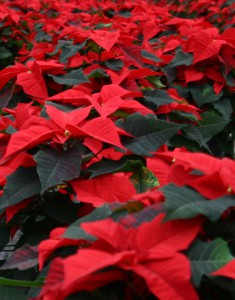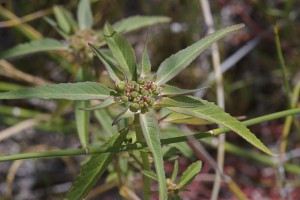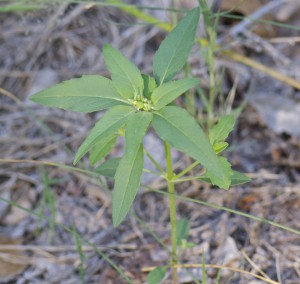Scientific names: Euphorbia pulcherrima, (Poinsettia), Euphorbia davidii (Toothed poinsettia)

Euphorbia pulcherrima (Poinsettia) by Cristina Salvador.
Plant Family: Euphorbiaceae
Common Name: Poinsettia
Article by Susan Bruneni
We all know the beauty poinsettias contribute to holiday décor today. But Aztec kings in the 14th-16th Centuries were already using these plants to adorn their surroundings. Caravans of the festive plants would journey from the lower altitudes where the plant grew into the higher altitudes where the Aztecs lived (in what is now Mexico City). Imagine a parade of poinsettias winding through our city. The Aztecs called poinsettias “Cuetlaxochitl.” The sap was used to control fevers and the bracts were used to make a reddish dye.
The first European description of Cuetlaxochitl appears in writings of 17th-Century Spanish botanist Juan Balme. In Mexico around the same time Spanish Franciscan Friars in southern Mexico noted the timely winter display of brilliant red and included the plants in their Nativity processions and services.
The botanical name, Euphorbia pulcherrima, meaning “very beautiful” was assigned to the poinsettia by the German botanist, Wilenow. Joel Roberts Poinsett was the first United States Ambassador to Mexico in the 1820s. He returned to South Carolina with cuttings and began propagation in his greenhouse. A plant that produced colorful displays during winter was fascinating, although it required specialized care outside of its native temperate climate. The Bartram family garden and commercial nursery in Pennsylvania was the first to market the plant. As it grew in popularity the name Euphorbia pulcherrima was replaced with the common name poinsettia.

Euphorbia davidii (Toothed poinsettia) by Janice Tucker
There are a number of other native poinsettias in the American southwest, including Euphorbia davidii (toothed poinsettia) found at Leonora Curtin Wetland Preserve. Most of the native species range from greens to slightly red brachts and bloom May through September. The flower itself is insignificant. The brachts are what provide color.
There are more than 2,000 species of Euphorbia in the world, ranging from annual weeds to trees. Most originate in Africa and Madagascar, and a significant percentage of these are succulent. All contain latex and have a unique flower structure. The cultivated poinsettia is not in itself toxic, but if grown by very large commercial establishments, there is no guarantee that sprays or chemicals used do not contain toxins. A number of the native species are extremely toxic, including the toothed poinsettia.

Euphorbia davidii (Toothed poinsettia) by Janice Tucker
In the early 1900’s the Ecke family of southern California cultivated the native Euphorbia pulcherrima for sale as landscape plants and cut flowers (as a landscape plant in frost-free sections of southern California the poinsettia is a magnificent spreading shrub up to 12 feet tall, often used for patio covers). Eventually the Ecke family grew poinsettias in greenhouses as potted plants and today is recognized as the leading producer of poinsettias in the United States. Ecke sells poinsettia starts world-wide.
Newman’s Nursery in Santa Fe plants the tiny starts in July. They will be routinely re-potted as they grow and will be ready by Thanksgiving. “We start with a portion of one greenhouse and by the time they are in the largest pots, we are using most of our greenhouses for close to 10,000 plants,” says Malcolm Newman. “The production of color in the brachts is related to the amount of daylight, so we make certain there is no artificial light,” he says.
“By the time you take a poinsettia home, all you need to do is provide a spot with good natural light and check it every few days. Let it dry slightly but not too much between waterings,” says Malcolm.
Euphorbia pulcherrima has journeyed through centuries in caravans, paraded in nativity pageants in tiny villages and now travels to commercial outlets and to your home or business. It is the most popular houseplant in the world, and even has its own day to celebrate. National Poinsettia Day is December 12. Take a moment to appreciate your poinsettia and honor its lengthy history as a way to celebrate winter.


